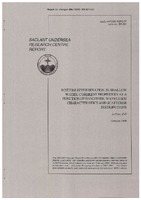| dc.description.abstract | Scattering physics are often modeled using the Helmholtz equation for computational reasons. Likewise, propagation loss to and from scattering regions are often treated in a like manner. The usual approach for generating reverberation time series therefore requires a numerical Fourier synthesis which can obscure the physics of reverberation phenomenology. Here we model the reverberation process approximately using normal modes and perform the Fourier synthesis explicitly under a narrow band approximation. The modes are allowed to interact with the bottom individually, but the interaction of the modes at the bottom is also retained. Therefore the approach allows pathological propagation phenomena such as convergence zones to be explicitly modeled. As a natural result of the broadband nature of the analysis, the interaction of the modes with each other at the bottom is seen to be governed by the bandwidth of the analysis and the dispersive properties of the waveguide. The result is that modes which interact coherently at bottom patches at early time may decorrelate at late times, in ways which are determined by the mean propagation physics of the waveguide and the reverberation analysis band. In the interests of keeping the approach as general as possible, the physics of the bottom scattering process are specified by the user. These physics are supplied in the form of local bottom scattering functions, which will generally be related to the mode shape functions and their derivatives at and in the bottom, which are sensitive to the detailed bottom structure and the incident grazing angles of each mode. This approach makes it possible to model several of the more popular bottom scattering models, such as perturbation theory and Lambert's law, within the framework of a general reverberation model. All scattering is assumed to be weak, so that a small imaginary part of the model eigenvalues is sufficient to account for energy loss due to scattering, and local, so that the field scattered at any particular part of the bottom is due only to the bottom properties at that particular point. This latter approximation serves as a restriction on the ability of the model to accommodate large scale scatterers such as facets or other target type features, but is useful for modeling clutter, the intended objective. | |
